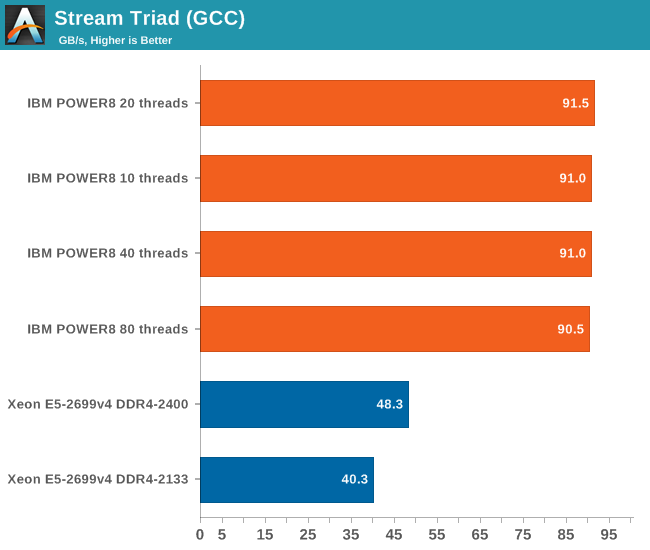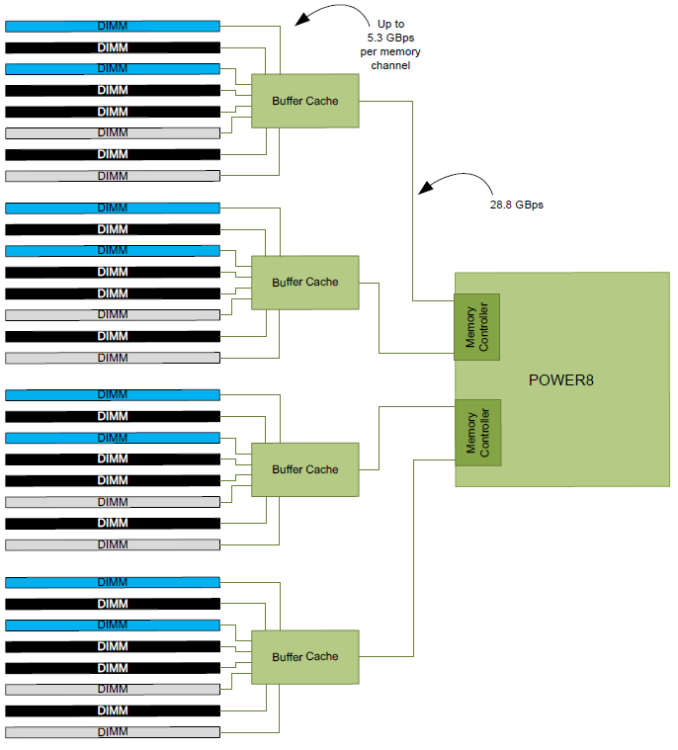Assessing IBM's POWER8, Part 1: A Low Level Look at Little Endian
by Johan De Gelas on July 21, 2016 8:45 AM ESTMemory Subsystem: Bandwidth
As we mentioned before, the IBM POWER8 has a memory subsystem which is more similar to the Xeon E7's than the E5's. The IBM POWER8 connects to 4 "Centaur" buffer cache chips, which have both a 19.2 GB/s read and 9.6 GB/s write link to the processor, or 28.8 GB/s in total. So the 105 GB/s aggregate bandwidth of the POWER8 is not comparable to Intel's peak bandwidth. Intel's peak bandwidth is the result of 4 channels of DDR4-2400 that can either write or read at 76.8 GB/s (2.4 GHz x 8 bytes per channel x 4 channels).
Bandwidth is of course measured with John McCalpin's Stream bandwidth benchmark. We compiled the stream 5.10 source code with gcc 5.2.1 64 bit. The following compiler switches were used on gcc:
-Ofast -fopenmp -static -DSTREAM_ARRAY_SIZE=120000000
The latter option makes sure that stream tests with array sizes which are not cacheable by the Xeons' huge L3 caches.
It is important to note why we use the GCC compiler and not vendors' specialized compilers: the GCC compiler is not as good at vectorizing the code. Intel's ICC compiler does that very well, and as result shows the bandwidth available to highly optimized HPC code, which is great for that code in the real world, but it's not realistic for multi-threaded server applications.
With ICC, Intel can use the very wide 256-bit load units to their full potential and we measured up to 65 GB/s per socket. But you also have to consider that ICC is not free, and GCC is much easier to integrate and automate into the daily operations of any developer. No licensing headaches, no time consuming registrations.

The combination of the powerful four load and two store subsystem of the POWER8 and the read/write interconnect between the CPU and the Centaur chips makes it much easier to offer more bandwidth. The IBM POWER8 delivers a solid 90 GB/s despite using old DDR3-1333 memory technology.
Intel claims higher bandwidth numbers, but those numbers can only be delivered in vectorized software.











124 Comments
View All Comments
HellStew - Wednesday, July 27, 2016 - link
It depends what kind of software you are running. If you are running giant backend workloads on x86, you can seamlessly migrate that data to PPC while keeping custom front ends running on x86.aryonoco - Saturday, July 23, 2016 - link
Johan, maybe the little endian-ness makes a difference in porting proprietary software, but pretty much all open source software on Linux has supported BE POWER for a long time.If you get the time and the inclination Johan, it would be great if you could say do some benchmarks on BE RHEL 7 vs LE RHEL 7 on the same POWER 8 system. I think it would make for fascinating reading in itself, and would show if there are any differences when POWER operates in BE mode vs LE mode.
aryonoco - Saturday, July 23, 2016 - link
Actually scrap that, seems like IBM is fully focusing on LE for Linux on POWER in future. I'm not sure there will be many BE Linux distributions officially supporting POWER9 anyway. So your choice of focusing on LE Linux on POWER is fully justified.HellStew - Wednesday, July 27, 2016 - link
Side note: Once you are running KVM, you can run any mix of BE and LE linux varieties side by side. I'm running FedoraBE, SuSE BE, Ubuntu LE, CentOS LE, and (yes a very slow copy of windows) on one of these chipsrootbeerrail - Saturday, July 23, 2016 - link
If a machine is completely isolated, it doesn't matter much to the machine. I personally find BE easier to read in hex dumps because it follows the left-to-right nature of English numbers, but there are reasons to use LE for human understanding as well.The problem shows up the instance one tries to interchange binary data. If the endian order does not match, the data is going to get scrambled. Careful programming can work around this issue, but not everyone is a careful programmer - there's a lot of 'get something out the door' from inexperienced or lazy people. If everything is using the same conventions (not only endian, but size of the binary data types (less of a problem now that most everything has converged to 64-bit)), it's not an issue. Thus having LE on Power makes the interchange of binary data easier with the X86 world.
errorr - Friday, July 22, 2016 - link
Great Article! Just an FYI, the term "just" as in "just out" on the first page has different meanings on opposite sides of the Atlantic and is usually avoided in writing for international audiences. I'm not quite sure which one is used her. The NaE would mean 'just out' in that it had come out right before while the BrE would mean it came out right after the time period referenced in the sentence.xCalvinx - Friday, July 22, 2016 - link
awesome!!..keepup the good work..looking forward to Part2!! ... actualy cant wait.. hurryup lol.. :)double thumbsup
Mpat - Friday, July 22, 2016 - link
Skylake does not have 5 decoders, it is still 4. I know that that segment of the optimization manual is written in a cryptic way, but this's what actually happened: up until Broadwell there are 4 decoders and a max bandwidth from the decoder segment of 4 uops. If the first decoder (the complex one) produces 4 uops from one x86 op, the other decoders can't work. If the first produces 3, then the second can produce 1, etc. this means that the decoders can produce one of these combinations of uops from an x86 op, depending on how complex a task the first decoder has: 1/1/1/1, 2/1/1, 3/1, or 4. Skylake changes this so the max bandwidth from that segment is now 5, and the legal combinations become 1/1/1/1, 2/1/1/1, 3/1/1, and 4/1. You still can't do 1/1/1/1/1, so there is still only 4 decoders. Make sense?ReaperUnreal - Friday, July 22, 2016 - link
Why do the tests with GCC? Why not give each platform their full advantage and go with ICC on Intel and xLC on Power? The compiler can make a HUGE difference with benchmarks.Michael Bay - Saturday, July 23, 2016 - link
It`s right in the text why.